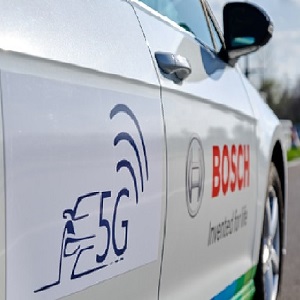5G Netmobil solution for connected traffic

5G NetMobil project develops real-time communication solutions to boost safety and efficiency
- Research project advances the state of the art in direct vehicle-to-vehicle and vehicle-to-infrastructure communication.
- Its results pave the way to standardization and mass production.
- Sixteen partners – major players, medium-sized enterprises, and research institutions – are finding solutions for key challenges in automotive real-time communication.
Safer, more convenient, greener connected vehicles that can communicate with roadside infrastructure in real time reduce emissions and the risk of accidents. This communication requires a stable and reliable data link provided by high-performance 5G, the new fifth-generation wireless technology for cellular networks, or by Wi-Fi-based alternatives (ITS-G5).
Sixteen research institutions, medium-sized enterprises, and major players have been working toward this goal over the past three years in the 5G NetMobil research project. They are now presenting their results which will enable major strides for a new era in mobility.
“With the 5G NetMobil project, we have achieved decisive milestones on the road to fully connected driving and are demonstrating how modern communication technologies can make our road traffic safer, more efficient, and more economical, all at the same time,” says Thomas Rachel MdB, parliamentary state secretary in the German Ministry of Education and Research. His ministry had funded this research project with 9.5 million euros. The groundwork done in this project in the areas of networks, security, and communication protocols now underpins efforts to standardize specifications, develop new business models, and ramp up the partners’ first production runs.
A launch pad for innovative traffic engineering
In many traffic situations, it is virtually impossible for drivers to see everything they need to, such as pedestrians crossing convoluted intersections or vehicles suddenly emerging from blind alleys. Radar, ultrasonic, and video sensors are the eyes of modern vehicles. They monitor the traffic situation around the vehicle, but they cannot see around corners or behind obstacles. Direct vehicle-to-vehicle (V2V), vehicle-to-infrastructure (V2I) and vehicle-to-network (V2N) communication enables vehicles to share data in real time with one another and their surroundings – even data on things that cannot be seen. The partners in the 5G NetMobil project are using this communication capability to develop tools such as a crossing assistant to protect pedestrians and cyclists at blind intersections. A camera installed in the roadside infrastructure detects pedestrians and warns vehicles within just a few milliseconds to prevent critical situations, for instance, when a car turns into a side street. Another item on the research agenda is platooning. In the future, commercial vehicles will be able to join up in convoy-like platoons where synchronized acceleration, braking, and steering enables trucks to operate at very close ranks thanks to V2V communication. This automated drafting – that is, tailgating another vehicle to ride in its slipstream – reduces fuel consumption and boosts safety on freeways. Experts from the participating companies and universities have laid out the groundwork for platooning with vehicles less than ten meters apart and for parallel platooning in agriculture. “The work of the research project is relevant to a wide range of applications. This not only benefits project partners from industry and research, but especially road users,” says Dr. Frank Hofmann from Robert Bosch GmbH, who is coordinating the research project on the manufacturing end.
The insights gained in this project are now flowing into the global standardization of communications infrastructure. They are cornerstones for partner companies’ further development efforts.–Dr. Frank Hofmann, Robert Bosch GmbH
Paving the way to standardization and new business models
This research project’s brief was to find solutions to key challenges in automotive real-time communication. There’s a good reason for this: direct V2V and V2I communication has to be failsafe, with high data rates and low latency, for fully connected driving to become reality. But what happens if the quality of the data link changes, leaving less bandwidth available for direct V2V communication? The experts developed an agile “quality of service” concept to detect changes in the provided network quality and alerts the connected driving functions accordingly. This way, the distance between vehicles in a platooned convoy can be increased automatically when network quality decreases. Another focal point of this research was to break the main cellular network down into discrete virtual networks (slicing). A separate subnet is now reserved for safety-critical functions such as alerting drivers to pedestrians at an intersection. This safeguard ensures data communication for these functions is always enabled. Another discrete virtual network handles data transmissions to stream videos and update the road map. Its operations can be temporarily suspended when the data rate dips. This research project has also made significant contributions to hybrid communication where the more stable connection – either the cellular network technology or a Wi-Fi-based alternative – is used to prevent the data link from dropping out while the vehicle is on the move. “The insights gained in this project are now flowing into the global standardization of communications infrastructure. They are cornerstones for partner companies’ further development efforts,” Hofmann says.

